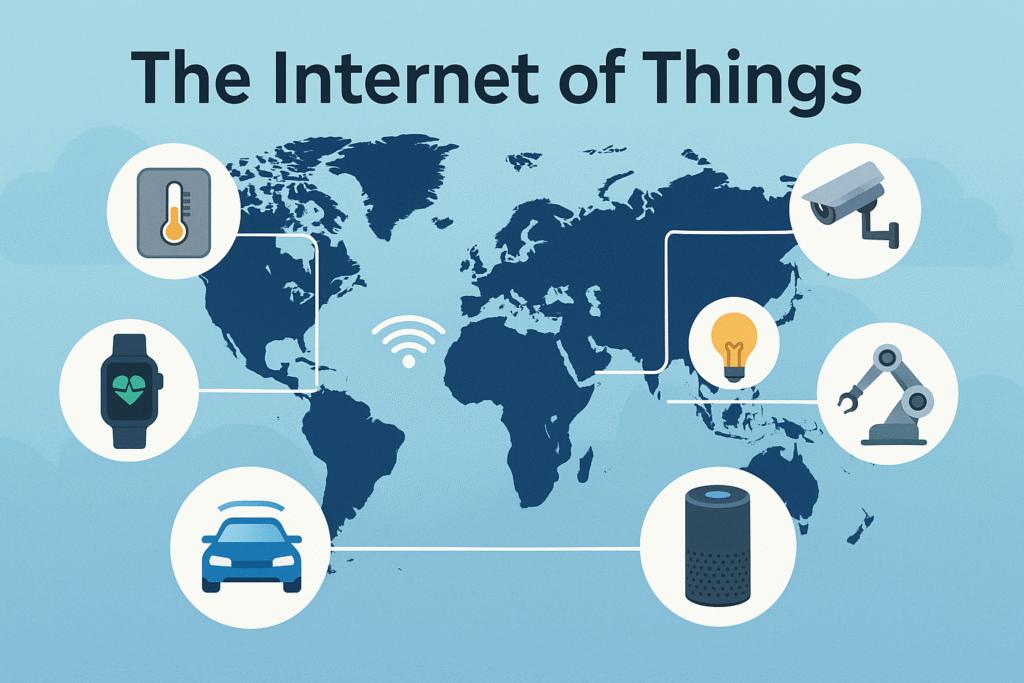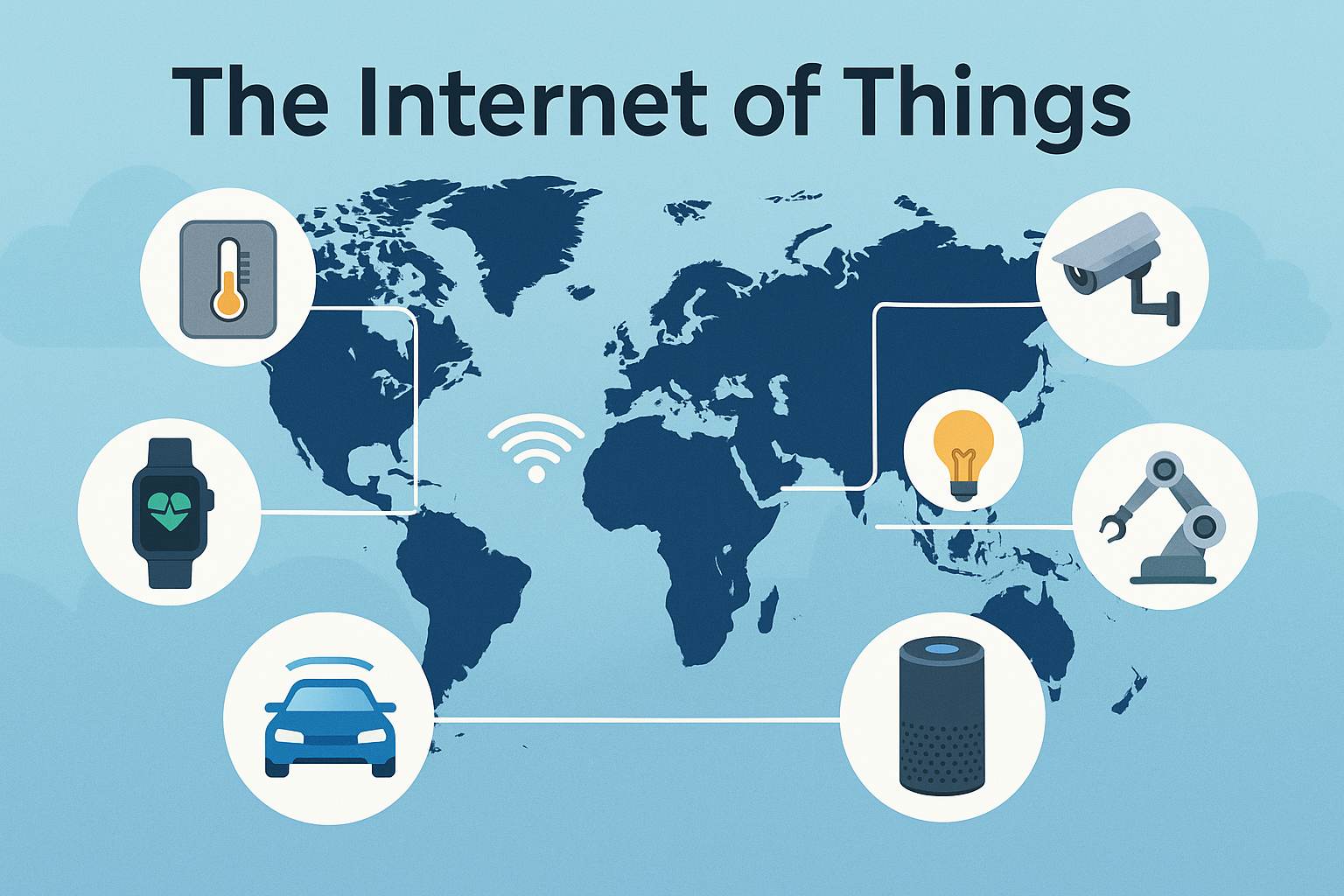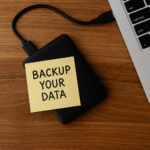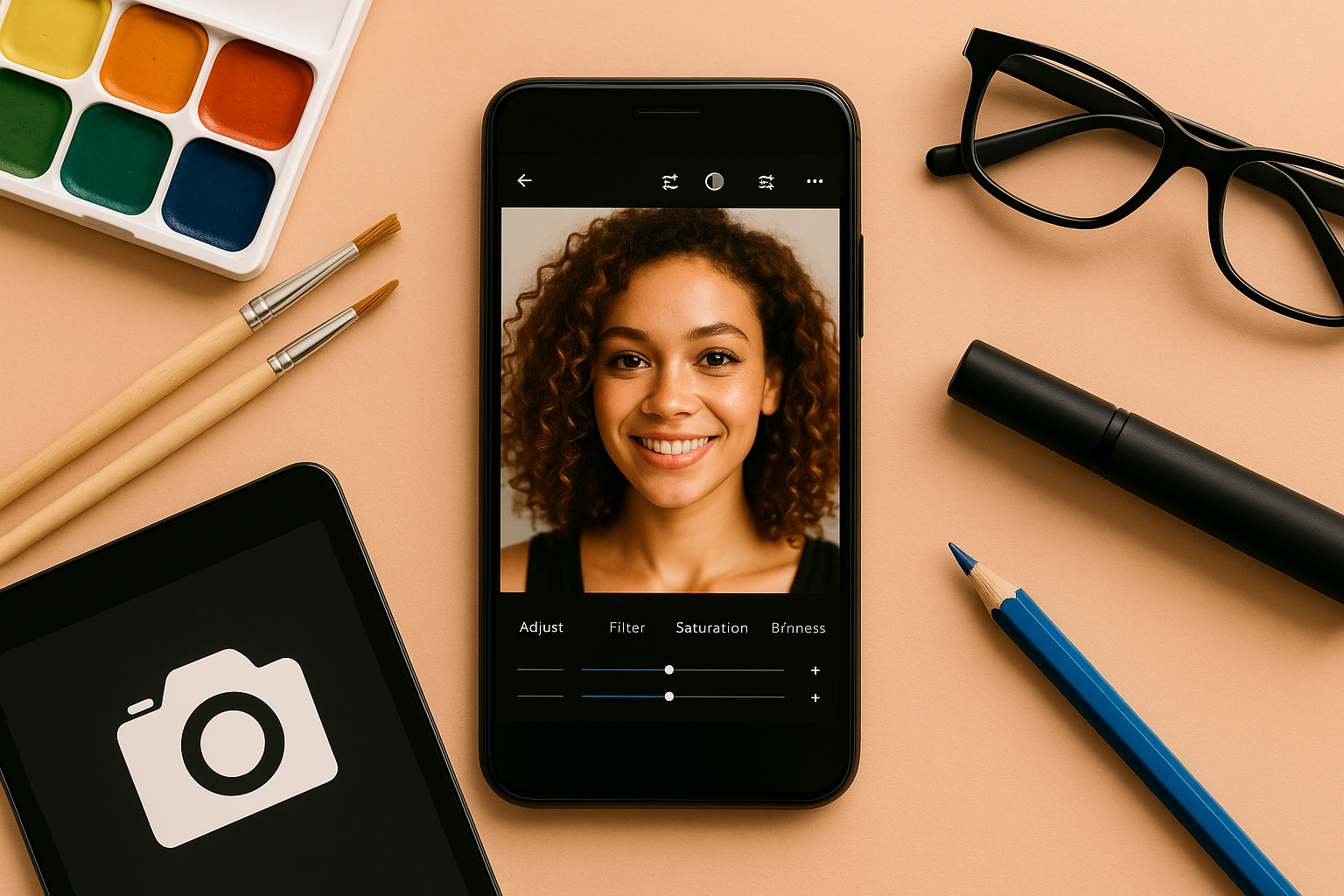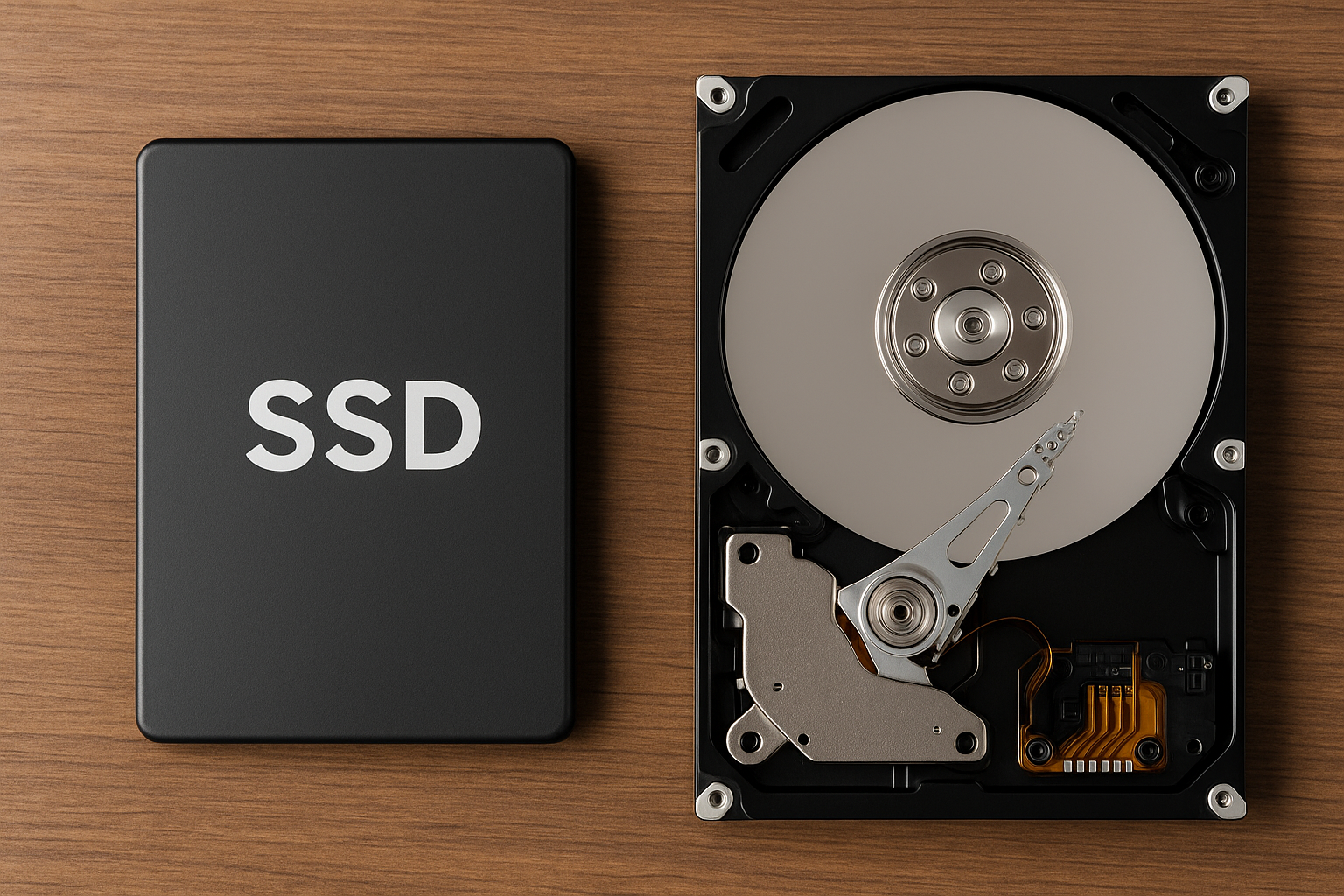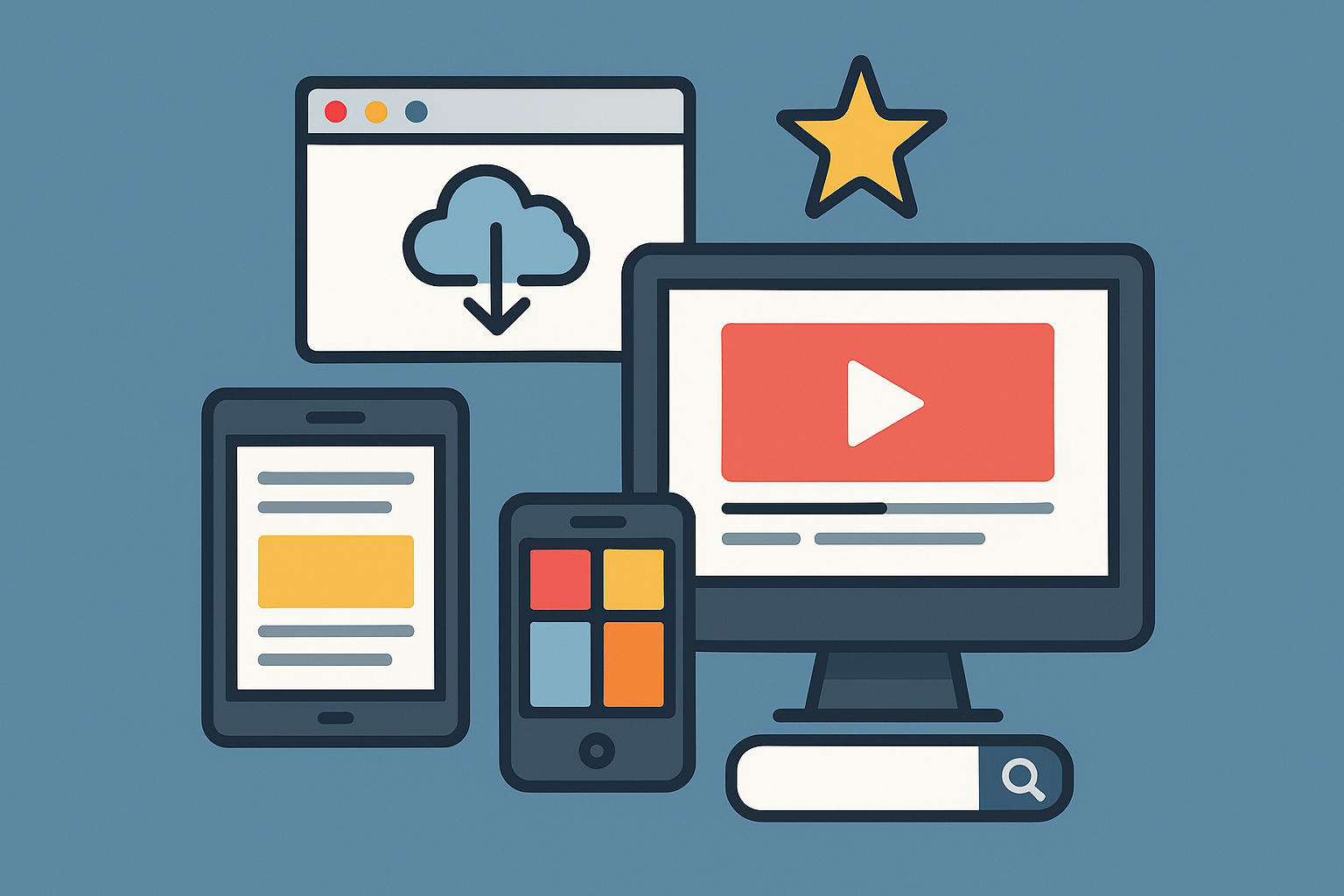The Internet of Things, or IoT, is more than a tech buzzword — it’s already shaping how we live, work, and interact with everyday devices. From smart thermostats to connected cars, IoT is everywhere, and its influence is growing rapidly.
In this article, you’ll understand what IoT really is, how it works, and where it’s already being used in 2025 — often without you even realizing it.
What Is the Internet of Things?
The Internet of Things refers to the network of physical objects — “things” — embedded with sensors, software, and other technologies that allow them to connect and exchange data over the internet.
These “things” can be:
- Appliances
- Vehicles
- Wearables
- Medical equipment
- Industrial machines
- Even entire buildings
In short, if it has a sensor and can communicate online, it’s part of the IoT.
How Does IoT Work?
Every IoT system has a few key components:
- Device or Sensor – Captures data from the environment (like temperature, motion, or usage)
- Connectivity – Sends the data over Wi-Fi, Bluetooth, 5G, or other networks
- Data Processing – A computer or cloud service analyzes the data
- Action or Output – The system responds or sends alerts (e.g., adjusting a thermostat or sending a phone notification)
For example:
A smart thermostat measures room temperature → Sends data to the cloud → You adjust it remotely from your phone → It learns your habits and adjusts automatically over time.
Where Is IoT Already Being Used?
You may not notice it, but IoT is already all around you — in homes, cities, workplaces, hospitals, and beyond.
Let’s explore the most common use cases.
1. Smart Homes
Smart homes are one of the most popular applications of IoT. Common devices include:
- Smart speakers (like Amazon Echo, Google Nest)
- Smart lights (turn on/off with your voice or app)
- Smart plugs and switches
- Thermostats that learn your preferences
- Smart refrigerators that alert you when groceries run low
- Robot vacuum cleaners that map your house
Benefits:
- Increased convenience and comfort
- Energy savings
- Enhanced security (smart locks, cameras, motion sensors)
2. Wearable Devices
Wearables like smartwatches and fitness bands track:
- Heart rate
- Steps
- Sleep quality
- Blood oxygen levels
- Stress levels
Popular devices: Apple Watch, Fitbit, Garmin, Samsung Galaxy Watch
Benefits:
- Encourages healthier habits
- Helps detect early health problems
- Syncs data with apps for analysis
3. Connected Cars
Modern cars are packed with IoT sensors and connectivity:
- GPS tracking
- Real-time diagnostics
- Collision alerts
- Driver behavior tracking
- Remote vehicle start/stop
Electric vehicles, like Teslas, take it even further with over-the-air updates and autonomous features.
Benefits:
- Safer driving
- Predictive maintenance
- Enhanced navigation and performance
4. Healthcare and Medical Devices
The IoT is transforming healthcare with devices like:
- Remote patient monitoring tools
- Smart inhalers
- Connected insulin pens
- Wearable ECG monitors
- Smart pill dispensers
Hospitals also use IoT for:
- Tracking equipment location
- Monitoring patient vitals
- Managing inventory
Benefits:
- Improves patient care
- Reduces hospital stays
- Supports elderly or at-home patients
5. Smart Cities
Cities are adopting IoT to improve infrastructure and services:
- Smart traffic lights that reduce congestion
- Public Wi-Fi systems
- Environmental monitoring (air quality, noise, water)
- Waste management (smart bins alert when full)
- Parking sensors that guide drivers to empty spots
Benefits:
- More efficient use of resources
- Reduced pollution
- Safer and more livable urban environments
6. Industry and Manufacturing (IIoT)
Industrial IoT, or IIoT, involves sensors and automation in factories:
- Machine monitoring to predict failures
- Automated supply chain systems
- Real-time energy management
- Robotic arms with AI sensors
Benefits:
- Increases productivity
- Lowers downtime and maintenance costs
- Improves workplace safety
7. Agriculture
Smart farming is growing thanks to IoT tools like:
- Soil moisture sensors
- Drones for field monitoring
- Automated irrigation systems
- Livestock trackers
Benefits:
- Higher crop yields
- More efficient water use
- Early detection of diseases or pests
8. Retail
Stores are using IoT to enhance the shopping experience:
- Smart shelves that track inventory
- Connected dressing rooms with suggestions
- Beacons that send personalized promotions
- Checkout-free systems (like Amazon Go)
Benefits:
- Better customer experience
- Fewer stockouts
- Faster service
Benefits of IoT in Everyday Life
- Convenience: Automate routine tasks like turning off lights or adjusting temperature
- Safety: Get alerts for unusual activity at home or in your car
- Health: Monitor vital signs and encourage fitness goals
- Efficiency: Use less energy, water, or fuel with smart systems
- Productivity: Automate repetitive tasks at work or home
Challenges and Risks of IoT
As powerful as IoT is, it comes with risks:
1. Privacy
Many devices collect personal data. Without proper security, that data can be misused or stolen.
2. Security
IoT devices are often the target of cyberattacks. Weak passwords and outdated software can be entry points for hackers.
3. Compatibility
Not all devices work together. Lack of standardization can create setup frustrations.
4. Dependence on Internet
Most devices need an internet connection — if it goes down, some features won’t work.
How to Use IoT Safely
Here are a few simple steps to protect yourself:
- Change default passwords
- Update device firmware regularly
- Use strong Wi-Fi security (WPA3)
- Enable two-factor authentication when possible
- Be selective — only install devices from trusted brands
What’s Next for IoT?
In the coming years, IoT will continue to evolve:
- AI Integration: Smarter predictions, personalized automation
- 5G Expansion: Faster data for more connected devices
- Edge Computing: Processing data on the device itself, not in the cloud
- More Interoperability: Devices from different brands will work together seamlessly
Final Thoughts: IoT Is Already Part of Your Life
The Internet of Things isn’t coming — it’s already here. Whether you’re aware of it or not, many of your devices are already connected, collecting and exchanging data to make your life easier, safer, and more efficient.
As long as you stay informed and take basic precautions, IoT can be one of the most helpful and transformative technologies in your day-to-day routine.
